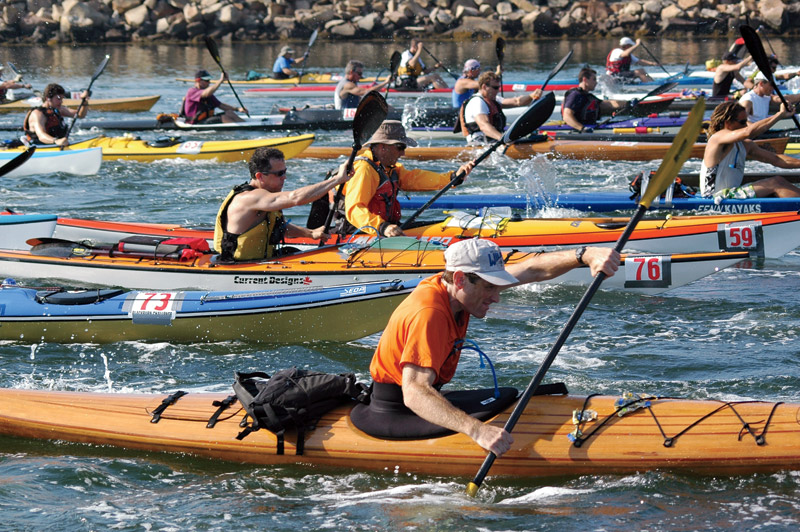Around Cape Ann With a Paddle
The 20-mile Blackburn Challenge, “the East Coast’s premier open-water human-powered boat competition,” is named for a Gloucester fisherman who famously froze his fingers to his oars in order to row back from God knows where in the middle of winter in 1883. The good news is he survived. The bad news is he lost enough […]

Kayakers try to get ahead of the pack at the start of the Blackburn Challenge men’s race.
Photo Credit : Friery, DrewThe 20-mile Blackburn Challenge, “the East Coast’s premier open-water human-powered boat competition,” is named for a Gloucester fisherman who famously froze his fingers to his oars in order to row back from God knows where in the middle of winter in 1883.
The good news is he survived. The bad news is he lost enough of his digits to be thereafter known as the “Fingerless Navigator.” (He did go on to complete two solo transatlantic sails.)
My older brother Tom and I had never paddled in open ocean or entered a kayak race. What brought us to the “skipper’s meeting” at Gloucester High School one recent July day was alluringly simple: the prospect of circumnavigating Cape Ann. We’d been born and raised on this mound of granite, but we’d never crossed the Straitsmouth Island channel or rounded the working quarry headland where the Annisquam River empties into the Atlantic. We’d never crossed the great expanse of Sandy Bay, where the sunny, curtain-lifting view exposes Granite Pier, Pigeon Cove Harbor, and our onetime neighborhood beach, Old Garden. Of course you don’t have to be a native to want to circumnavigate Cape Ann. It’s famous enough, pretty enough, and popular enough. One hundred fifty paddlers had siagned up, each presumably willing to risk the fact that “occasionally the water can be very rough, with strong winds and high waves.” “Expect to be out of sight and fully independent,” repeated the meeting chief. Translation: Save yourself.
Looking around, I noticed that my fellow skippers were a diverse, average-looking lot: men and women, young and old, fathers and mothers, sons and daughters. When we got down to the race start, the boats were no different: handsome Grand Banks dories, spidery 40-foot outrigger canoes, tubular rowing shells. We departed at five-minute intervals according to boating class. The dories went first, then the open craft, and finally us, the two-person touring kayakers.
We were merrily enjoying the tranquil Annisquam when we heard a thrashing sound behind us and found ourselves enveloped by a beehive of hell-bent, racing paddlers. It was all we could do to get out of their way. In the freeway that we now occupied, we quickly pulled out of the main channel and watched in wonder as we learned what real racers looked like. It would, of course, be the last we saw of them.
Up until Andrew’s Point, roughly seven miles in, we just felt our way along. We paddled, we talked, we marveled at the old Victorian houses jutting into the sea. Then our friend Chip and his daughter pulled up right behind us. Our competitive juices kicked in and we began paddling for all we were worth, not letting up until we neared Straitsmouth Island.
We passed Old Garden on Rockport’s northeastern edge, then Cape Hedge, Long Beach, and Good Harbor. The 150 boats that had started the race were well spread out now, and only a few of us kept to the same slogging rhythm. It was like a road race in which you gingerly pass someone, only to be passed again.
Finally we got to the long home stretch: Gloucester Harbor, big and beautiful and lumpy with diesel fishing boats coming and going. Our time was four hours 34 minutes, sixth out of seven in our division. Not exactly impressive–but as we wrestled our boat up onto the sands of Pavilion Beach, one of the speedsters came by to check us out.
“You paddled that?” he gasped. “Right on!”
For more information about the race, visit: blackburnchallenge.com


